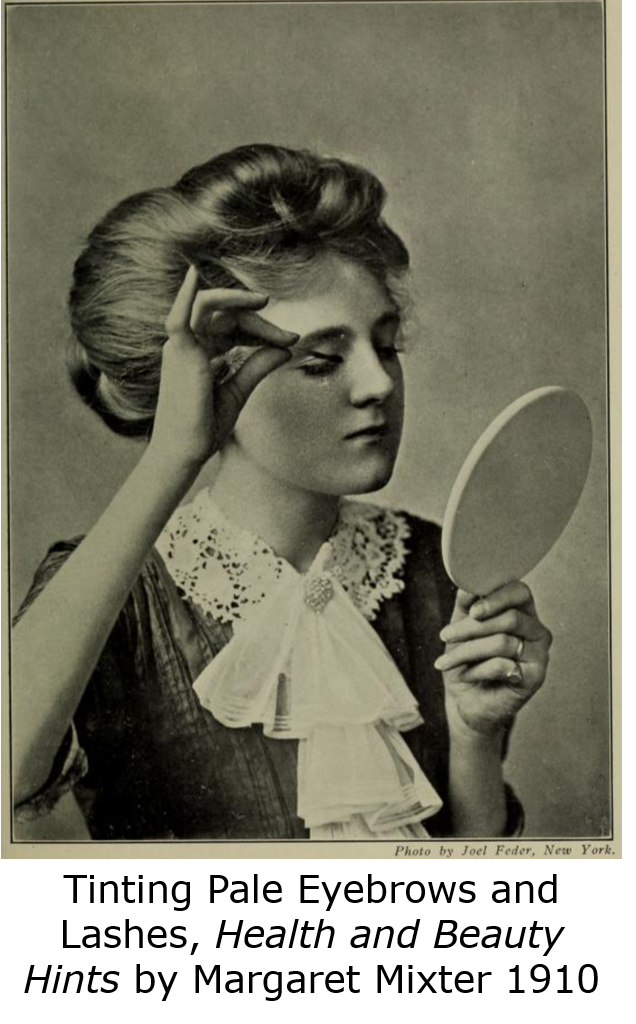By Suzanne Norquist
When I prepared to make some videos for a project, my twenty-six-year-old daughter said,
“Oh, Mom, we need to do something about those eyebrows.”
Not a new
concept, but what is considered the perfect brow? Thick? Thin? Arched? Unibrow? And how
is perfection achieved?
Answers to these questions have varied throughout history. Ancient Egyptians desired bold, prominent brows—like a god would have. Ancient Greeks and Romans believed unkempt eyebrows showed purity, and unibrows were prized. In the Middle Ages, hairy brows distracted from the natural beauty of the forehead. Therefore, women sculpted and plucked them away.
Smaller, more
shapely brows persisted into the early 1900s. In her 1910 book, Health and
Beauty Hints, Margaret Mixter describes
the perfectly shaped brow as “a swallow’s wing, the line long and sweeping, the
hair short and thick without being coarse.”
Margaret Mixter recommended conditioning and training. Generally, some kind of oil was used. Here is her recipe for Eyebrow and Lash Tonic:
Red
Vaseline, 5 grams; Boric acid, 10 centigrams. Make into a smooth paste, and
massage into the brows at night, also rubbing lightly on the lashes at the
roots.
Vaseline has been
a well-known brand since 1870, and the pink version is still available today. Boric
Acid has mild antiseptic, antifungal, and antiviral properties.
Massaging eyebrows every night could improve their health, and a soft brush helped shape them.
Coloring wasn’t
encouraged, particularly with permanent colors, which would damage the hair. A blackened
piece of burnt cork or some Indian ink could darken them a little if needed.
Trimming the
eyebrows was never recommended, as it would create a coarse, unkempt look. Nor
was plucking. The 1910 beauty book suggests electrolysis for hair removal.
Early
versions of electrolysis would make me nervous. It was invented in 1875, and
commercial machines became available in 1900. By the early 1900s, schools of electrolysis and
dermatology were popping up.
In this 1898 advertisement, Professor Newby explains the benefits of electrolysis. Not only could he take care of skin blemishes and superfluous hair, but he also specialized in rheumatism, paralysis, tumors, and cancer. He used the latest electrical scientific discoveries.
What women
wouldn’t endure in the name of fashion.
Eyebrows are
just one aspect of an attractive expression. The beauty book also gives some
advice related to eyelashes, mostly a little conditioning and trimming.
In antiquity, long, lush lashes represented youth and fertility. Burnt cork or coal often created the effect. By the Middle Ages, too much hair was viewed as erotic, and lashes were plucked. That trend didn’t last for long. Versions of mascara existed in the 1800s.
Artificial
eyelashes made an appearance in the late 1800s when Parisian women sewed hairs
on their eyelids for enhancement. And, of course, everyone adopts Paris
fashions. An article in an 1897 newspaper in Telluride, Colorado, describes the
procedure for sewing human hair to the eyelids to extend the lashes.
Beauticians
experimented with different varieties of false lashes. In 1903, the New York
Press reported, “In a hair store on Broadway, a novelty item is being sold in
the shape of long, luxuriant eyelashes, which can be adjusted in two minutes
and will wear for one month. They cost $3 a pair.”
They probably
weren't sewn on if they could be adjusted that quickly.
The first patent for glue-on artificial lashes was awarded to Anna Taylor, a Canadian woman, in 1911. However, falsies didn’t really become popular until 1916, when actress Seena Owen wore them in the movie Intolerance.
Crazy enough, I can barely see the eyelashes in the picture above. Perhaps without them, her eyes completely disappeared.
Beauty trends
for brows and lashes haven’t changed much in the last hundred years. Most of us
don’t cringe anymore, as these treatments have been refined and are commonplace.
And, who am I to criticize? I wear mascara for a day of hiking in the mountains. All women want to put on their best face.
***
Four historical romances celebrating the arts of sewing and quilting.
"Mending
Sarah’s Heart" by Suzanne Norquist
Rockledge,
Colorado, 1884
Sarah
seeks a quiet life as a seamstress. She doesn’t need anyone, especially her
dead husband’s partner. If only the Emporium of Fashion would stop stealing her
customers, and the local hoodlums would leave her sons alone. When she rejects
her husband’s share of the mine, his partner Jack seeks to serve her through
other means. But will his efforts only push her further away?
For
a Free Preview, click here: http://a.co/1ZtSRkK
She authors a
blog entitled, Ponderings of a BBQ Ph.D.










Thanks for posting! What we women don't go through for "beauty's" sake! At least most of these fixes weren't toxic!!
ReplyDeleteYes. These were much milder than things in some of my other posts (until they tried false eyelashes).
DeleteFun post! Thanks for sharing.
ReplyDeleteWaxing eyebrows or laser treatments are the latest now. I rarely wear mascara as I get older because it often makes my eyes water. This was a fascinating article.
ReplyDeleteThanks. I wonder what people will think of waxing or laser treatments 100 years from now.
Delete